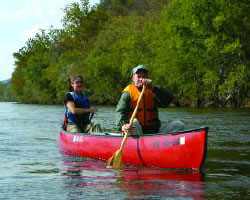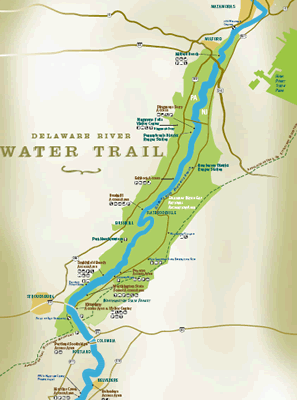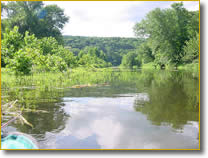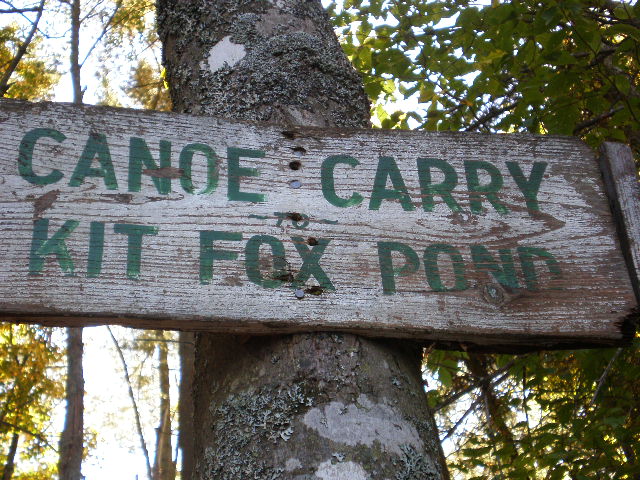 Extending approximately 280 miles the Delaware River is the longest un-dammed stretch of river east of the Mississippi River. Because the river is partially protected, it is free from large scale commercial and industrial development. It is clean and clear and serves as a watershed for about 15 million people located in New York City and New Jersey, and also serves as a major recreation attraction for the people of eastern Pennsylvania, New Jersey and New York City. The Delaware River is so rich in recreational, scenic, historic and natural resources that nearly three quarters of the river (about 150 miles) is designated as part of the National Wild and Scenic Rivers System.
Extending approximately 280 miles the Delaware River is the longest un-dammed stretch of river east of the Mississippi River. Because the river is partially protected, it is free from large scale commercial and industrial development. It is clean and clear and serves as a watershed for about 15 million people located in New York City and New Jersey, and also serves as a major recreation attraction for the people of eastern Pennsylvania, New Jersey and New York City. The Delaware River is so rich in recreational, scenic, historic and natural resources that nearly three quarters of the river (about 150 miles) is designated as part of the National Wild and Scenic Rivers System.
History of the Delaware Water Gap National Recreational Area
The Delaware Water Gap National Recreational Area was established due to the Tocks Island Dam that was to be constructed just several miles upstream of the Delaware Water Gap. This dam was to be one of the largest in the United States stretching almost 40 miles upstream with the purpose of providing electricity and water resources to Pennsylvania, New York and New Jersey residents. The Federal government acquired 70,000 acres of property in preparation for the dam but due to economics and local opposition the dam project was dropped in 1975, and in 1978 the acquired property was added to the National Wild and Scenic Rivers System. The Tocks Island Dam bill was finally ended by Congress in 1992. The Delaware Water Gap National Recreation Area resulted from the 70,000 acres acquired for the now defunct Tocks Island Dam project.
 Delaware River Water Trail
Delaware River Water Trail
The Delaware River Water Trail will include boat access points and camping sites for public use. With the 75 mile Lehigh River Water Trail and 142 mile Schuylkill River Water Trail as tributaries to the Delaware River, the Delaware River Water Trail system will provide some of the finest and most accessible water recreation in the northeastern United States.
Popular activities on the Delaware River Water Trail include boating, fishing, swimming, camping, hunting, hiking, bird watching, sightseeing along canal towpaths and bike routes. It is no wonder that much of the Delaware River makes a great water trail. Nonprofit environmental and recreational organizations, local residents and businesses, and federal, state and local governments have joined in a cooperative effort to guide and enhance river access opportunities through the development of a water trail system. This system includes uniform signage, maps, a trail guide and an interactive web site.
Middle Delaware
The Middle Delaware River is more of a solitary river experience in a relatively natural setting. It stands apart from the upper and lower Delaware River sections because it is managed by the National Park Service as is largely part of the Delaware Water Gap National Recreation Area. The scenery and definition of the river changes as it winds its way through Matamoras, Pennsylvania and Port Jervis, New York. It’s here where we leave the whitewater of the upper section for a wider and slower scenic river. US 209 parallels the river on the Pennsylvania side, while the historial Old Mine Road parallels the river on the New Jersey side. This scenic section of the Delaware River is very popular for large groups of canoe campers and fall foliage paddling trips. Once you complete your canoe trip consider touring some early American History along the Old Mine Road.
 One of the more secluded and scenic stretches on the Middle Delaware is the Walpack Bend beginning where the Bushkill Creek enters on the Pennsylvania side, and ends just below the Big Flatbrook on the New Jersey side. Below Walpack Bend, the river separates the Kittatinny ridgeline in New Jersey and the Blue Mountain in Pennsylvania, forming the Delaware Water Gap. This section of the river is also notorious for its seemingly endless headwinds, so be prepared to endure some rigorous paddling through this section. The Middle Delaware features long slow pools and occasional shallow riffles that add excitement that any paddler will appreciate. And all paddlers will appreciate the tranquil beauty of the Middle Delaware, especially on a warm summer evening. There are plenty of primitive campsites on both sides of the river and many of its islands for overnight stays. Be aware that camping is not permitted on several of the islands.
One of the more secluded and scenic stretches on the Middle Delaware is the Walpack Bend beginning where the Bushkill Creek enters on the Pennsylvania side, and ends just below the Big Flatbrook on the New Jersey side. Below Walpack Bend, the river separates the Kittatinny ridgeline in New Jersey and the Blue Mountain in Pennsylvania, forming the Delaware Water Gap. This section of the river is also notorious for its seemingly endless headwinds, so be prepared to endure some rigorous paddling through this section. The Middle Delaware features long slow pools and occasional shallow riffles that add excitement that any paddler will appreciate. And all paddlers will appreciate the tranquil beauty of the Middle Delaware, especially on a warm summer evening. There are plenty of primitive campsites on both sides of the river and many of its islands for overnight stays. Be aware that camping is not permitted on several of the islands.
Lower Delaware
The lower non-tidal Delaware River is the longest and busiest of the three sections, stretching nearly 76 miles from just below the Delaware Water Gap to the tidal waters at Trenton, New Jersey and Morrisville, Pennsylvania. Most of the land abutting the Lower Delaware is private property. Boating regulation enforcement on this section is managed by the New Jersey Marine Police and Pennsylvania Fish and Boat Commission. The commercialize section of the Delaware is rich with history and culture, and you can discover plenty of interesting restaurants, shopping, historic and cultural activities to do on the Pennsylvania and New Jersey shores. Because this section of the river is more populated than the middle and upper sections, and with its many boat access points, the Lower Delaware is also bustling with activity during the summer. Besides kayakers and tubers there are power boats and personal water craft. Paddlers need to be aware of other boaters and use caution when running a section of the river that is heavily used by power boaters. .
Download a PDF map of the Delaware River Water Trail provided by the Delaware River Greenway Partnership.
When planning a weekend canoe camping trip on the Delaware River Water Trail you choose commercial or park service camping. For more information on camping in the Delaware Water Gap National Recreational Area contact the National Park Service or visit the Dingmans Campground website.
Useful Delaware River Links
Kittatinny Canoes Adventure Sports
Delaware River Facts – The Tocks Island Dam Project
Download the Delaware Water Gap Map
Tidal Delaware Water Trail

